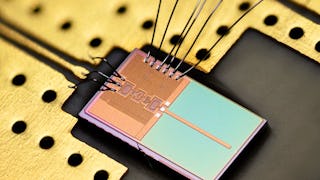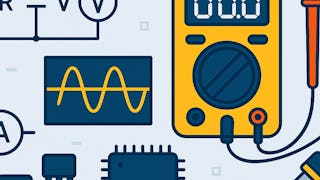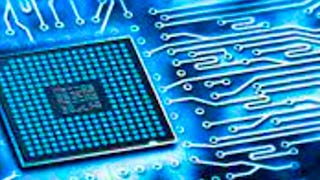This unique Master-level course offered by the Center for Wireless Technology Eindhoven (CWT/e) of the Eindhoven University of Technology, The Netherlands, provides students with in-depth knowledge and hands-on experience on RF and mmWave circuit design.


RF and millimeter-Wave Circuit Design


Instructors: Carlos Mendes, Jr.
25,240 already enrolled
Included with
(244 reviews)
Skills you'll gain
Details to know

Add to your LinkedIn profile
19 assignments
See how employees at top companies are mastering in-demand skills

There are 6 modules in this course
This module will introduce the student to the RF and mm-Wave Circuit Design course and to the topic of wireless systems. It will present the learning objectives, grading system, supporting material, introductory class, and design labs. Besides, it will show the student how to use the simulation tools and the equipment used in the design labs.
What's included
7 videos6 readings1 assignment1 discussion prompt
The module on Wireless Systems will introduce the student to the history of wireless technologies, wireless system design, and RF system specifications. Concepts about transceivers will be detailed, such as path loss, interference signals, receiver sensitivity, and transmitter output power. It also includes the first design lab, the system design of a Wireless Tin Can Telephone.
What's included
6 videos6 readings4 assignments1 peer review1 discussion prompt
The Amplifiers module will introduce the student to the basic concepts of amplifiers, types of power gain, and the most used amplifier topologies. The student will also learn about low noise amplifier matching and power amplifiers classes. The second design lab will focus on designing LNAs and PAs.
What's included
9 videos6 readings4 assignments1 peer review1 discussion prompt
The Mixers module will introduce the student to the working principle of RF mixers and their basic concepts. The difference between active and passive mixers will be explained, the advantages and drawbacks of balanced and unbalanced mixers will be detailed, and the mixer's noise performance highlighted. The third design lab will cover the design of up and down-conversion mixers.
What's included
5 videos6 readings4 assignments1 peer review1 discussion prompt
The Oscillators module will introduce the student to the working principles of frequency oscillators and their basic concepts, like condition to sustain an oscillation. The student will learn about different topologies of oscillators, why and how to tune oscillators, and the impact of noise in the oscillator's signal. At last, the influence of output buffering and breakdown voltage on oscillators will also be explained. The fourth design lab will focus on designing a Voltage Controlled Oscillator (VCO).
What's included
5 videos6 readings4 assignments1 peer review1 discussion prompt
The Synthesizers module will introduce the student to the working principles of frequency synthesizers and their basic concepts. The student will learn about the importance of using synthesizers in modern wireless communications, the Phase-Locked Loop types I and II, the advantages and drawbacks of using All-Digital PLL, and the impact of the PLL frequency synthesizer on the signal's noise performance. At last, the architecture and usage of fractional-N PLL frequency synthesizers will be detailed. The fifth and last design lab will contain the design of a frequency divider and a phase detector.
What's included
4 videos5 readings2 assignments1 peer review1 discussion prompt
Instructors


Offered by
Explore more from Electrical Engineering
 Status: Preview
Status: PreviewEindhoven University of Technology
 Status: Preview
Status: Preview
Birla Institute of Technology & Science, Pilani
 Status: Free Trial
Status: Free Trial
Why people choose Coursera for their career




Learner reviews
244 reviews
- 5 stars
76.63%
- 4 stars
20.49%
- 3 stars
1.63%
- 2 stars
0.40%
- 1 star
0.81%
Showing 3 of 244
Reviewed on May 13, 2024
Combination of Video lectures and simulation tutorials dovetail extremely well
Reviewed on Jul 15, 2021
Wish that there are more the Quizes tp answer and more details presentation slides
Reviewed on Sep 1, 2022
an excellent course on RF circuit component designing with a profound backgroud theory and literature.

Open new doors with Coursera Plus
Unlimited access to 10,000+ world-class courses, hands-on projects, and job-ready certificate programs - all included in your subscription
Advance your career with an online degree
Earn a degree from world-class universities - 100% online
Join over 3,400 global companies that choose Coursera for Business
Upskill your employees to excel in the digital economy
Frequently asked questions
To access the course materials, assignments and to earn a Certificate, you will need to purchase the Certificate experience when you enroll in a course. You can try a Free Trial instead, or apply for Financial Aid. The course may offer 'Full Course, No Certificate' instead. This option lets you see all course materials, submit required assessments, and get a final grade. This also means that you will not be able to purchase a Certificate experience.
When you purchase a Certificate you get access to all course materials, including graded assignments. Upon completing the course, your electronic Certificate will be added to your Accomplishments page - from there, you can print your Certificate or add it to your LinkedIn profile.
Yes. In select learning programs, you can apply for financial aid or a scholarship if you can’t afford the enrollment fee. If fin aid or scholarship is available for your learning program selection, you’ll find a link to apply on the description page.
More questions
Financial aid available,

